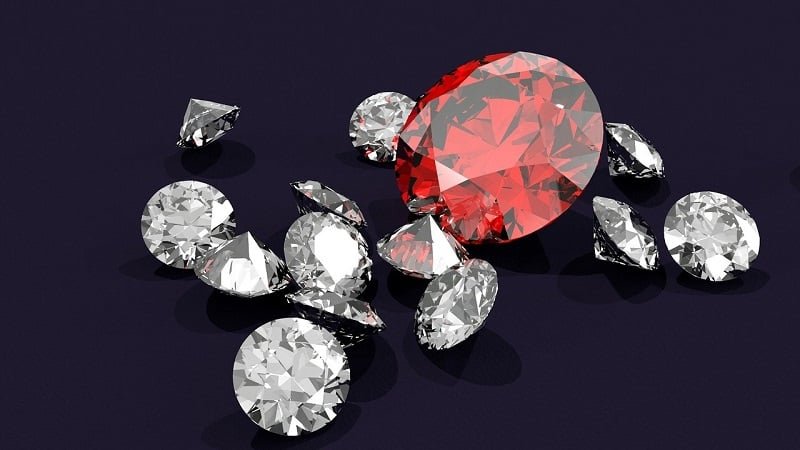Where to Buy Red Beryl

Table of Contents
One of the rarest occurring gemstones of the world, red beryl is a beautiful deep red stone desired by many. Even though the stone was discovered decades back, its production and distribution have not been established compared to other gemstones.
Two decades ago, the spectacular gem-quality red beryl was found at the Ruby Violet mine in the Wah Wah Mountains of southwestern Utah. Since that time, this material has remained one of the rarest color varieties of gem beryl. The continued limited scale of production offset its increased recognition and acceptance in the marketplace.
Therefore, many people worldwide, especially in the US and Japan, show interest in acquiring red beryl but fail to find open faceted markets due to the stone’s rarity. Moreover, this one-source gemstone is extremely rare to the point that its lab-grown counterparts don’t do justice, and people do not commonly demand them either.
So, Where Can You Buy Red Beryl From?
There currently is no common jewelry brand or shop that openly sells red beryl like other gemstones and jewelry pieces. In fact, most of these stones are either under the possession of the mine owners of red beryl in Utah or gemstone museums around the world.
Even if someone does want to own red beryl, fine pieces can sell for extremely high prices. Moreover, something that can come near to a normal person’s possession is pre-made red beryl jewelry pieces. That also through highly efficient and big jeweler names of the industry.
All in all, there is no easy way for someone like us to own red beryl. Unless you are a celebrity or an important person or someone with credible sources worldwide, possessing red beryl may only remain a dream of yours that may never come true.
Some Other Gemstones You Can Buy
Here is a list of other 14 equally beautiful and valuable red gemstones that are easy to buy compared to red beryl.
- Almandine Garnet (Pyrope)
- Burmese Ruby
- Carnelian
- Garnet
- Indian Ruby
- Japanese Red Coral
- Mogok Ruby
- Mozambique Ruby
- Pigeon Blood Ruby
- Red Coral (Moonga)
- Red Spinel
- Red Tourmaline
- Red Zircon
- Ruby (Manik)
All of these gemstones have a striking similarity of color with the red beryl. Not only can they be easily purchased pre-made jewelry but as a whole stone as it is. Later, you can even have them custom cut to make them look like red beryl or fit a unique shape of the jewelry piece.
Moreover, gemstones like rubies and zircons can easily be found in a range of prices and in combination with other metals like gold, silver, or platinum for added bling and value of the jewelry piece. Moreover, you can highlight these stones by pairing them up with diamonds to curate an heirloom piece to pass on to generations down the line.
In fact, in many Asian countries like the Middle East, India, China, and Japan, it is also an ongoing tradition to pass on valuable jewelry pieces embellished with stones to future generations. This is mainly why there is a high local demand for valuable jewelry pieces made of metals like gold, silver, and platinum and heavily embellished with stones.
Valuable Pigeon Blood Ruby vs. Red Beryl
Even though ruby itself is one of the most sought-after red gemstones in the world, the pigeon-blood variant of the stone is all the more rare and valuable. Many gemstone lovers and collectors compare the pigeon blood ruby’s rarity with red beryl.
The stark color similarity and the demand and value of the stones make both of them a highly desirable stones. However, the only difference between the two is that red beryl’s production has officially been commercially halted. On the flip side, pigeon blood ruby is being mined and prospected all around the world.
The reason is that even though it is a rarely occurring gemstone sub-type, mining for rubies is an ongoing project. Therefore, finding a pigeon blood variant amidst the search is definitely a lucky find. Miners continue to search the fields and find chunks of the stone hidden in the deepest of the pit but making it easily accessible to the world.
Even though certain inside sources suggest that mining for red beryl may start in coming years, the easy way around is to seek a pigeon blood ruby. Not only is it equally valuable, if not more, but it is also just as red, beautiful, and singularly occurring gemstone.
Conclusion
The formation of gem-quality red beryl at the Ruby Violet mine resulted from a unique set of geologic conditions within a cooling rhyolite flow due to the reaction and fractures of magma-derived gases, groundwater, and preexisting minerals and volcanic glass in the host rhyolite.
Over the past decade, significant projects were undertaken by two mining companies to investigate the potential for large-scale production of red beryl. While this large-scale mining has not continued, these efforts contributed to increased knowledge of the deposit and recognition of red beryl in the gem trade.
At present, a gem material and mineral specimens are being sold from the inventory of the Harris family, as well as from the GMI stockpile. With the deposit’s potential not fully exploited, further work at the Ruby Violet mine is expected to begin again soon.